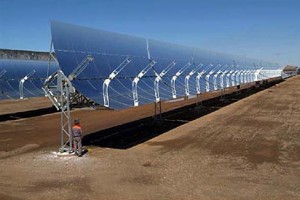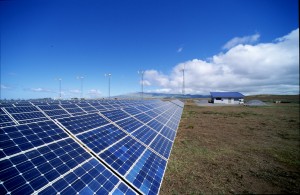According to the press release from the airport authority, Hon. Chief Minister Mr. Oommen Chandy inaugurated the 12 MWp solar power plant, on 18th August 2015, comprising of 46,150 solar panels laid across 45 acres near cargo complex. About 50,000 to 60,000 units of electricity will be consumed by the airport for all its operational functions, and this will be provided by those 46150 solar panels that generate electricity.
This is not something new for the Cochin International Airport, as there was already a 100 kWp solar PV Plant installed on the roof top of the arrival terminal block, and it is there since March 2013. Later, 1 MWp solar PV power plant was placed partly on the roof top and partly on the ground in the Aircraft Maintenance Hangar facility within the Airport premises.
Given how these two plans generated electricity and were successful in providing what was expected, Cochin International Airport Limited (CIAL) decided to scale up and set up a 12MWp solar PV plant, and this aids in the green initiative. The installation is going to be done by M/s Bosch Ltd.
For the need at night hours when sunlight is not available, CIAL has worked out a plan with Kerela State electricity board, where a power banking module will provide the power to the module during the day time, and at night, it would be bought back by CIAL. With this plant, the annual generation of power would account to about 18 million units (which according to CIAL, would normally be enough to power up 10000 homes for one year).
CIAL also said that they would be looking at more alternatives, and given how many water bodies the state has, they will look to take advantage of that and install dam-based solar panels, or hydro power projects to generate electricity with the renewable sources.
This installation will finish by May 2016, and the Chennai International Airport will be fully solar-power operated by then.
![Cochin International Airport to be completely powered by Solar energy According to the press release from the airport authority, Hon. Chief Minister Mr. Oommen Chandy inaugurated the 12 MWp solar power plant, on 18th August 2015, comprising of 46,150 solar panels laid across 45 acres near cargo complex. About 50,000 to 60,000 units of electricity will be consumed by the airport for all its operational […]](http://www.renewablesmart.com/wp-content/uploads/2015/08/solar-cochin-airport.jpg)
![India to respond to US WTO notice on domestic sourcing rules under National Solar Mission India has said it will respond to the United States’ notice challenging the domestic sourcing requirement in its National Solar Mission in 10 days’ time as stipulated under the rules of the World Trade Organization. The US, on Wednesday, filed an official dispute against India at the WTO claiming that the domestic sourcing rules flouted […]](http://www.renewablesmart.com/wp-content/uploads/2010/10/india-renewable-energy.jpg)
![US Approves Blythe Solar Power Project The biggest solar project that plans to provide power to more than 3,00,000 homes in southern California was permitted by the US interior department. The US$6 Bn, 1,000MW project, a joint venture of Solar Millennium AGand Ferrostaal AG, will be located on federal lands near Blythe, in the southern tip of California. “The Blythe Solar […]](http://www.renewablesmart.com/wp-content/uploads/2010/10/Solar-Millennium-Blythe-solar.jpg)

![Solar PV modules in India touches 1250MW The capacity of photovoltaic cells and modules in India is estimated to cross 750MW and 1250MW by the end of year 2010 as per report “Solar PV Industry 2010: Contemporary Scenario and Emerging Trends”. The report was released by R Chidambaram, principal scientific adviser, government of India, chief guest for the function with professor Juzer […]](http://www.renewablesmart.com/wp-content/uploads/2010/05/solar-photovoltaic-india-750x500.jpg)



